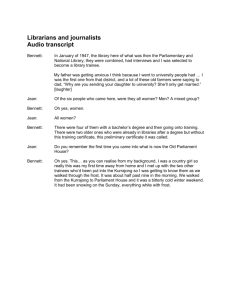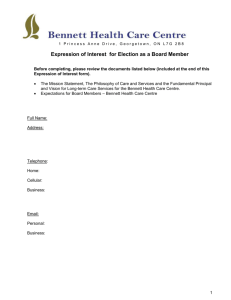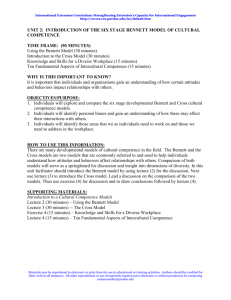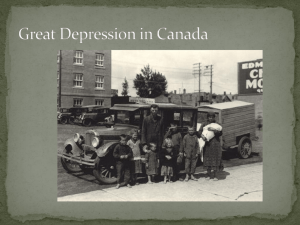Review of Jonathan Bennett`s A Philosophical Guide to Conditionals
advertisement
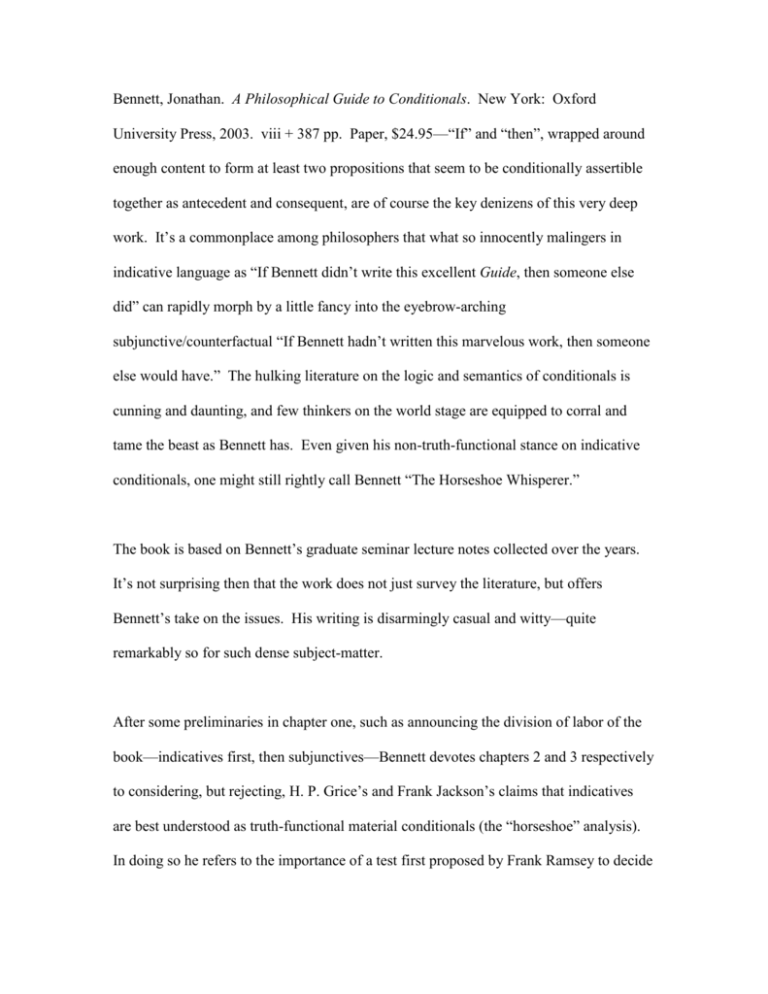
Bennett, Jonathan. A Philosophical Guide to Conditionals. New York: Oxford University Press, 2003. viii + 387 pp. Paper, $24.95—“If” and “then”, wrapped around enough content to form at least two propositions that seem to be conditionally assertible together as antecedent and consequent, are of course the key denizens of this very deep work. It’s a commonplace among philosophers that what so innocently malingers in indicative language as “If Bennett didn’t write this excellent Guide, then someone else did” can rapidly morph by a little fancy into the eyebrow-arching subjunctive/counterfactual “If Bennett hadn’t written this marvelous work, then someone else would have.” The hulking literature on the logic and semantics of conditionals is cunning and daunting, and few thinkers on the world stage are equipped to corral and tame the beast as Bennett has. Even given his non-truth-functional stance on indicative conditionals, one might still rightly call Bennett “The Horseshoe Whisperer.” The book is based on Bennett’s graduate seminar lecture notes collected over the years. It’s not surprising then that the work does not just survey the literature, but offers Bennett’s take on the issues. His writing is disarmingly casual and witty—quite remarkably so for such dense subject-matter. After some preliminaries in chapter one, such as announcing the division of labor of the book—indicatives first, then subjunctives—Bennett devotes chapters 2 and 3 respectively to considering, but rejecting, H. P. Grice’s and Frank Jackson’s claims that indicatives are best understood as truth-functional material conditionals (the “horseshoe” analysis). In doing so he refers to the importance of a test first proposed by Frank Ramsey to decide the acceptability or assertibility of a conditional (p. 28). The Ramsey test maintains that such acceptability of an indicative A→C is the conditional probability of the consequent C given the antecedent A (in Bennett’s notation π(C/A), p. 51). Following Dorothy Edgington, Bennett calls a compressed expression of the Ramsey test “the Equation”: P(A→C) = π(C/A), where P(A) > 0 (p.58). (The latter phrase captures Bennett’s claim of “zero-intolerance” of indicatives with false antecedents, p. 55.) By chapter 4 (p. 46) it’s clear that Bennett installs the Equation as the cornerstone of his theory of indicatives, and that chapter carefully presents the necessary probability calculus for its construction. Bennett’s labor in this regard is not easy going, however. Immediately in chapter 5 he confronts David Lewis’ “triviality result”, which proves in effect that the Equation is useless in objectively evaluating acceptability of conditional consequents as genuinely dependent on their antecedents. With that, Bennett forges on in chapter 6 (following Ernest Adams) to explore the claim that the use of indicative conditionals never objectively reports conditional probabilities but can only express subjective beliefs about them (in the fashion of metaethical expressivism, p. 106 f.). Then, chapter 7 argues that indicatives are thus not propositions and have no truth-value (the “NTV thesis”, p. 94), though that latter claim itself acquires some refining in chapter 8. Chapter 9 then applies Bennett’s full theory, cleverly modifying “Venn” (Euler?) diagrams to exhibit relative probabilities, to show that reasoning with indicatives is classically valid because probabilistic validity applies in those cases (p. 131). Chapters 10-23 constitute, for the most part, detailed elaboration and endorsement of the familiar Robert Stalnaker—David Lewis analysis of subjunctives (counterfactuals) in terms of possible worlds. Of course, this recipe is nonetheless served à la Bennett. Chapter 10 rejects Lewis’ extreme realism of possible worlds for an abstract form (p. 157). Bennett as well jettisons Lewis’ similarity relation to evaluate possible world resemblance, opting instead for a carefully delineated closeness of possible worlds that depends on precise definitions of forks and ramps that allow for comparing the divergence of possible worlds in a temporally fine-grained way (chapters 11-14; these latter terms are discussed in detail on p. 214 f.; the closeness relation is defined on p. 235). Chapters 15-21 address a wide variety of issues related to subjunctives, including a probabilistic “drop-truth” proposal that parallels NTV for indicatives (chapter 16), backward conditionals (chapter 18), and a rejection of Nelson Goodman’s account of subjunctives (chapters 20-21). Chapters 22 and 23 are devoted to analyzing various attempts to unify the two types of conditionals systematically, but Bennett ultimately concludes that they are unsatisfactory. Overall, Bennett’s achievement is nothing less than monumental. But as with the pyramids, which took sustained and unimaginably tedious work as well, one can appreciate such genius of accomplishment and still ask if the project itself was undertaken for entirely sound reasons. For example, Bennett frequently takes pains to refute this or that claim of William Lycan, but he does not finally force Lycan’s opposing linguistic-semantic approach to conditionals into conceptual bankruptcy. The book opens with a mentioned conditional, and it closes with one in use. Between is a golden treasure of edifying scholarship that, if not perfect, is nearly enough so.—V. Alan White, University of Wisconsin—Manitowoc.
